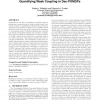Free Online Productivity Tools
i2Speak
i2Symbol
i2OCR
iTex2Img
iWeb2Print
iWeb2Shot
i2Type
iPdf2Split
iPdf2Merge
i2Bopomofo
i2Arabic
i2Style
i2Image
i2PDF
iLatex2Rtf
Sci2ools
ATAL
2011
Springer
2011
Springer
Towards a unifying characterization for quantifying weak coupling in dec-POMDPs
Researchers in the field of multiagent sequential decision making have commonly used the terms “weakly-coupled” and “loosely-coupled” to qualitatively classify problems involving agents whose interactions are limited, and to identify various structural restrictions that yield computational advantages to decomposing agents’ centralized planning and reasoning into largely-decentralized planning and reasoning. Together, these restrictions make up a heterogeneous collection of facets of “weakly-coupled” structure that are conceptually related, but whose purported computational benefits are hard to compare evenhandedly. The contribution of this paper is a unified characterization of weak coupling that brings together three complementary aspects of agent interaction structure. By considering these aspects in combination, we derive new bounds on the computational complexity of optimal DecPOMDP planning, that together quantify the relative benefits of exploiting different f...
Agent Interaction | ATAL 2011 | Intelligent Agents | Interaction Structure | Markov Decision Processes |
| Added | 12 Dec 2011 |
| Updated | 12 Dec 2011 |
| Type | Journal |
| Year | 2011 |
| Where | ATAL |
| Authors | Stefan J. Witwicki, Edmund H. Durfee |
Comments (0)

